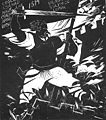Gyula Derkovits
Gyula Derkovits , actually Gyula József Derkovits (born April 13, 1894 in Szombathely , † June 18, 1934 in Budapest ) was a Hungarian painter and graphic artist.
Life
Gyula Derkovits first learned to be a carpenter in his father's workshop. A sign painter friend taught him the basics of drawing. Since the First World War was over for him in 1916 - one hit paralyzed his left arm - he moved to Budapest and there learned painting and engraving from Károly Kernstock . After the suppression of the communist council republic of Béla Kun , he emigrated to Vienna, where he became a member of the KPÖ . Here he was inspired by German Expressionism .
His most important work - according to the Hungarian National Museum, which can show at least 17 of his paintings - is the woodcut series 1514 , which is about the Dózsa peasant uprising . He revised this series of woodcuts in 1931 and reissued them as copper engravings. Towards the end of his life he left Expressionism and combined strict composition with lyrical colors in the presentation. The Hungarian National Museum praises its very individual style.
Gyula Derkovits suffered from illnesses throughout his life. He died poor and almost forgotten when he was only 40 years old in Budapest. He is known to friends of bizarre erotic graphics under the name Jules Derkovits.
György Dózsa 1928, Dózsa woodcut series
literature
- Éva Körner: Gyula Derkovits , Corvina, 1974, ISBN 963-13-1607-6
Web links
- Literature by and about Gyula Derkovits in the catalog of the German National Library
- Brief presentation of the Hungarian National Museum, with photo
| personal data | |
|---|---|
| SURNAME | Derkovits, Gyula |
| ALTERNATIVE NAMES | Derkovits, Gyula József |
| BRIEF DESCRIPTION | Hungarian painter and printmaker |
| DATE OF BIRTH | April 13, 1894 |
| PLACE OF BIRTH | Szombathely , Hungary |
| DATE OF DEATH | June 18, 1934 |
| Place of death | Budapest , Hungary |





